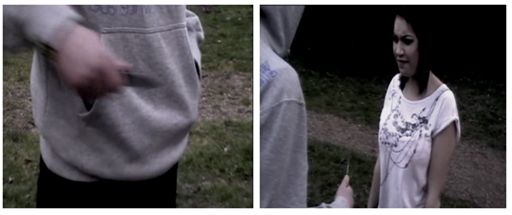We were asked to create a short film sequence around 45 seconds long in around groups of 2 or 3, this is to the tile: 'The Encounter'. We had around 4 days to finish filming, this meant that we had a time limit including time to re-film things during class, otherwise we would have to film in our own time
We were trying to demonstrate a knowledge and understanding of match on action, short/reverse shot and the 180-degree rule and an understanding of the rule of thirds. We used the match on action because this gave two different perspectives of the same shot and also allows for a more fluid and logical cut to the next shot as it may be changing location or to give a clearer view of what was currently happening. For example in the picture below it shows a person pulling out a knife then the shot following it shows who they are threatening with the knife.
We used the shot/reverse shot during a conversation, this allowed the audience to see facial expressions of the characters speaking or being spoken to and how they are reacting during the conversation. This gives the audience an insight of how the characters are feeling in that moment in time.
The 180-degree rule was the most important during the filming process, because if done correctly it made sure that characters were always on the same side of the screen throughout the short film, this is especially important to use as not to dis-orientate the audience while watching the film and not to confuse them. We made a few mistakes while filming which broke the 180 degree rule a few times and lighting was a big factor also when filming, we noticed this while watching back the footage and we had to re-film a fair amount of out shots. In the image below it shows that the camera can be anywhere on the side it started on for 180 degrees but if it were to cross the line without it clearly being shown to the audience then any angle past the line of action is not going to match any previous shots and baffle the audience.
The rule of thirds is applied by aligning a subject with the guide lines and their intersection points, placing the horizon on the top or bottom. The main reason for observing the rule of thirds is to discourage placement of the subject at the center, or prevent a horizon from appearing to divide the picture in half. When filming, it is common to line the body up to a vertical line and the person's eyes to a horizontal line. If filming a moving subject, the same pattern is usually followed, with the majority of the extra room being in front of the person or object. For example the goat in the image below being the object as seen the forefront of the goats body is being lined up with the first vertical line and its head it being aligned with the top horizontal line making sure that it is not in the centre of the shot.
I worked with Niraj Jadav and Jay Pabari, I think we worked well together as we made sure we got things done quickly and effieciently, while also making sure our shots matched the story board to a good degree of accuracy and that they were filmed to a good enough standard. It also helped that they were both also commited to getting the filming done, we all knew what were doing throughout the filming process; Jay was the camera man while Niraj and I were the characters in the film sequence. This meant that everything we did was easier to do and everyone in the group was cooperative.
While brainstorming ideas in class we ended up deciding that we should make the short film funny but doing so by using suspense, e.g. A stare off between the two characters then followed by a stupid comment or facial expression which wouldn't usually go with that scenario and I think that we applied this technique quite well in the short film. Our initial idea was derived from a true story which we exaggerated to create the humour we were looking for. During filming we found that using different types of angles on shots allows the audience to know how the character is feeling or what they actually are for example using a low angle shot makes the person in the shot seem more superior.
We did keep mainly to the storyboard but changed the initial establishing shot from nandos to the canteen in school due to the time limit we had to film which made filming nandos impractical. The change really worked to our advantage because when we decided to film our final shots in the canteen it was empty which made filming easier and less mistakes were made whereas when we filmed when the canteen was packed it was very difficult to get the right shots done properly.











No comments:
Post a Comment